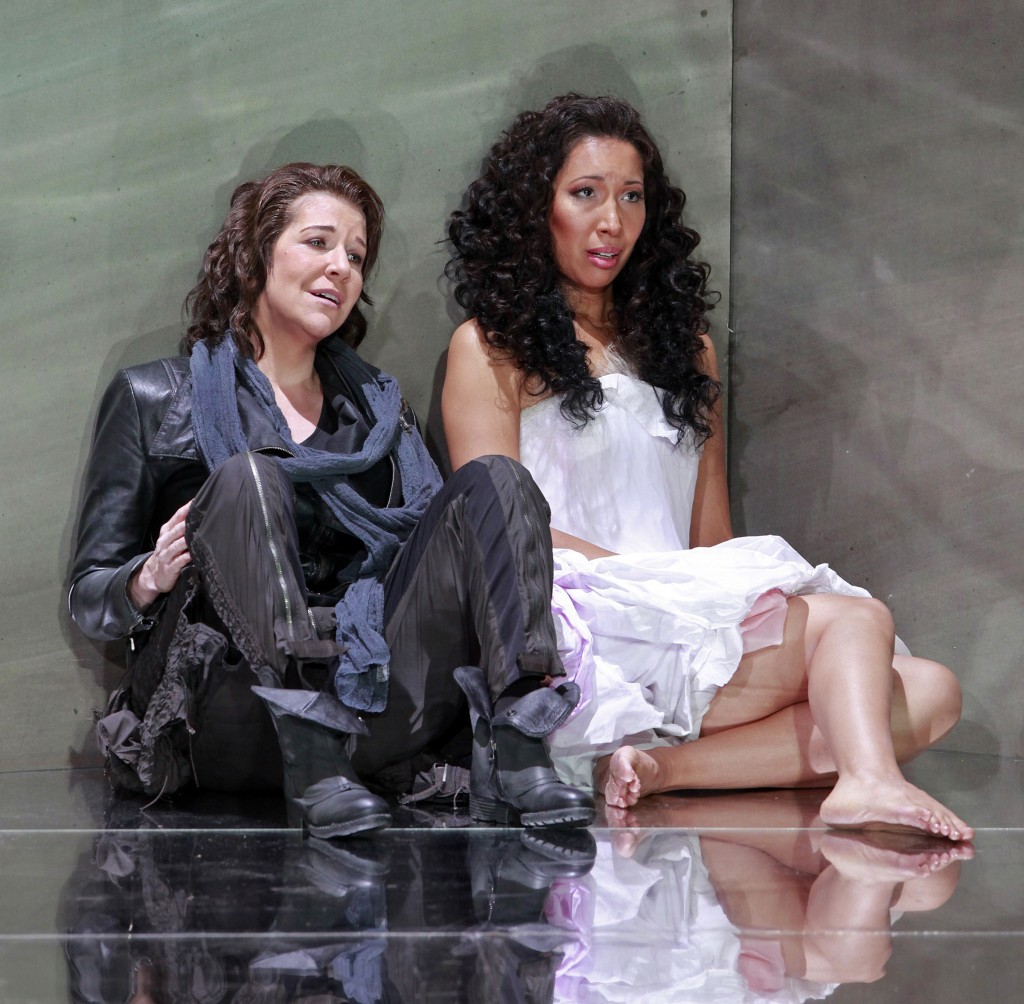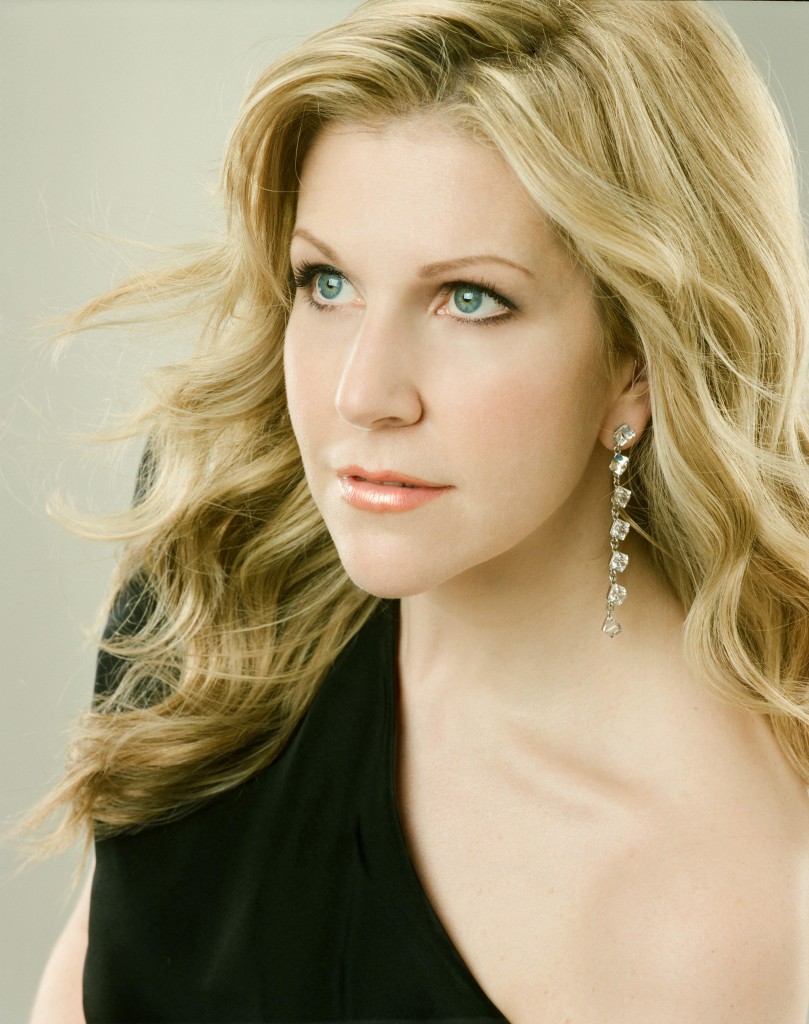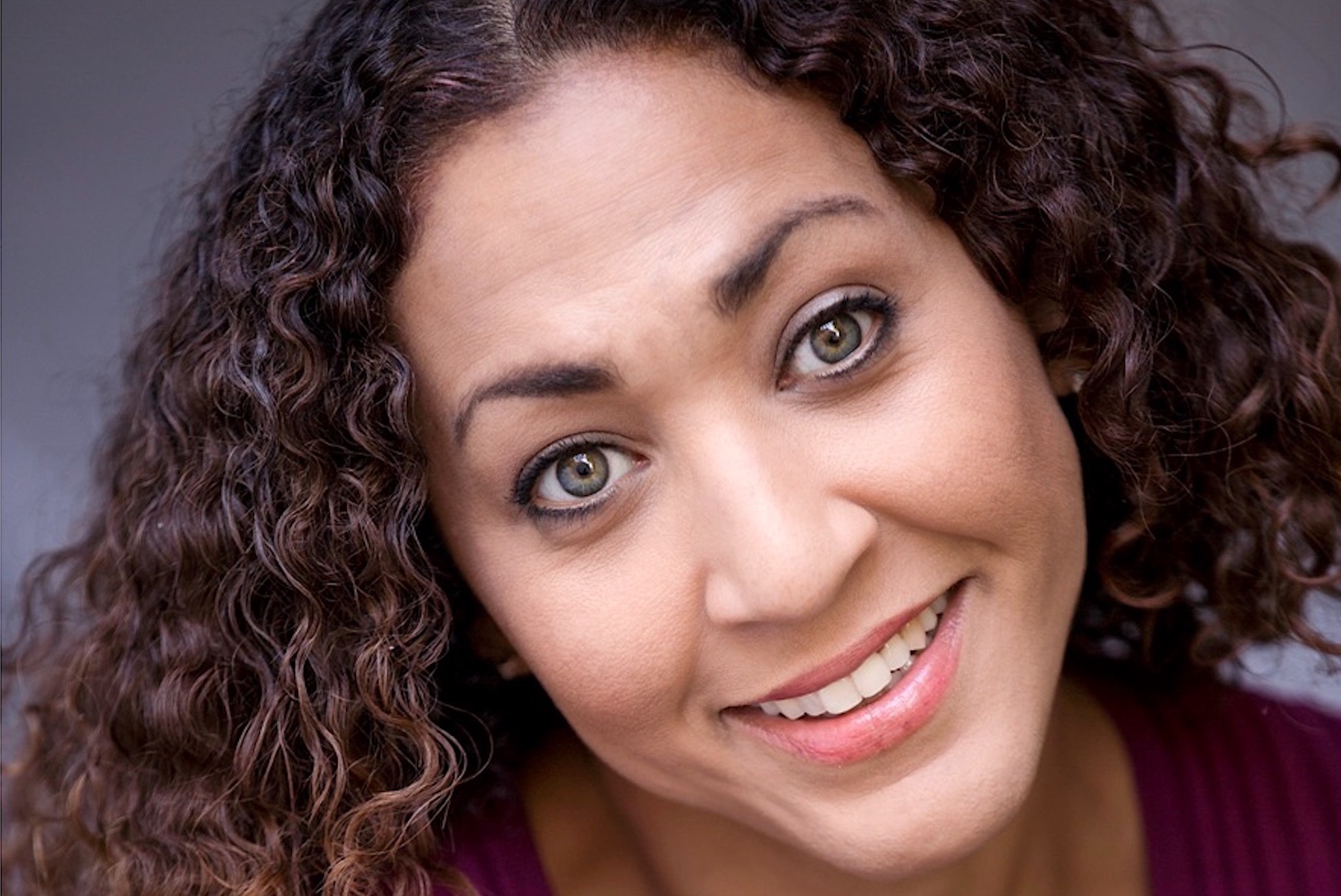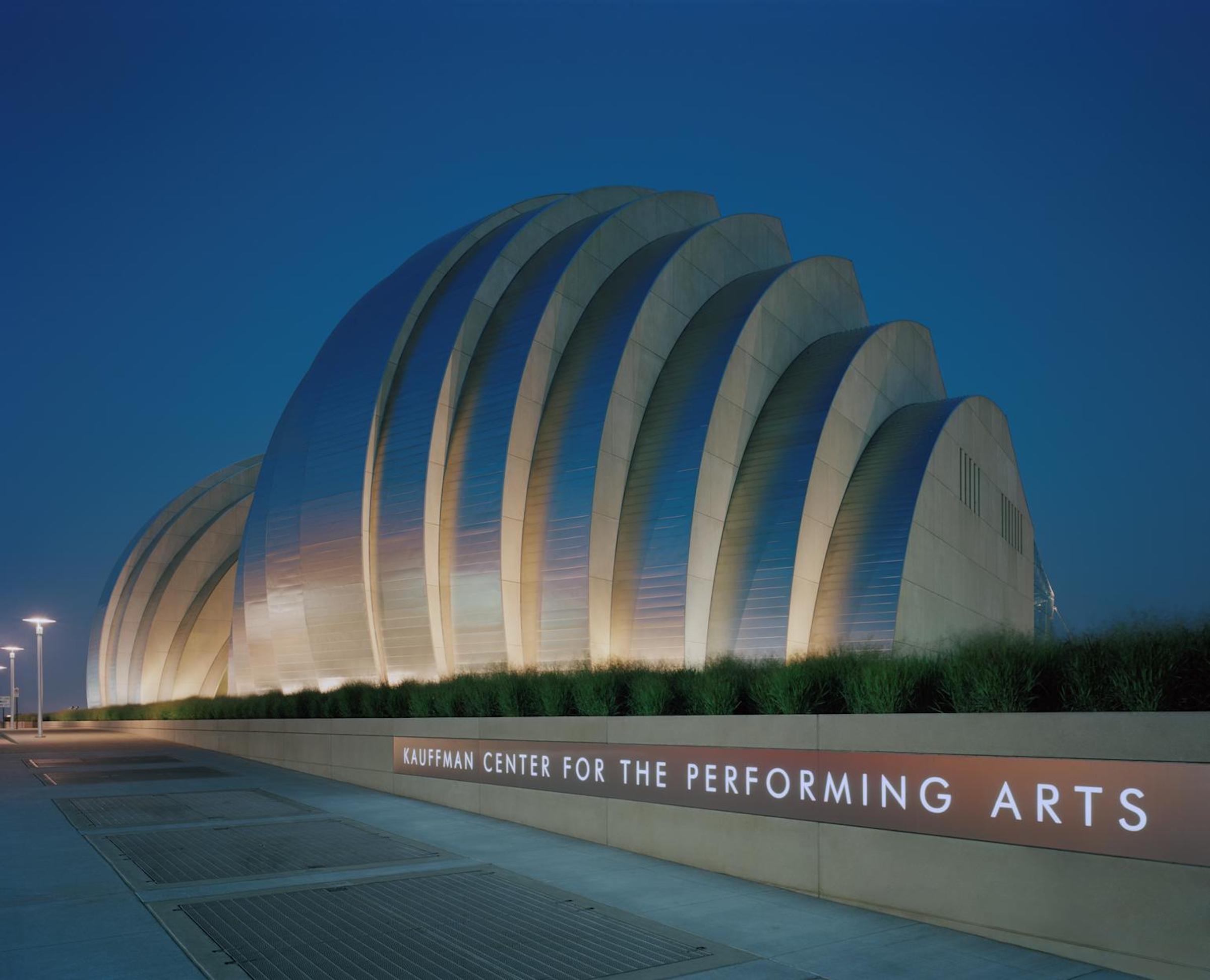O WILLIAM, WHEREFORE ART THOU: Lyric production of Bellini rarity sports stellar cast, native daughter
By Paul Horsley
Opera is such a collaborative art form that it cannot succeed unless music, acting, stage direction and design all work together to form a sort of magical fusion. The Lyric Opera has built an exceptional production of Bellini’s The Capulets and the Montagues for its season opener, with a team headlined by soprano Nicole Cabell and mezzo-soprano (and Our Town native) Joyce DiDonato and featuring tenor William Burden, stage director Kevin Newbury, music director Ward Holmquist and set and costume designer Victoria (“Vita”) Tzykun. Bellini’s opera, which opens September 21st, is based not on Shakespeare but on earlier Italian sources, and it focuses not just on the famous love-duo but also on the eternal subject of “personal lives that are affected by the merciless machine of war,” in Vita’s words. For Kevin, who is also making his Lyric debut, Bellini’s version is “really more about rival political factions. It’s still about the rivalry between families, of course, but there’s a lot more talk about the war around these characters.” Joyce, who has been singing Bellini’s Romeo since 2008, calls it one of the most demanding roles in her repertoire. It is an opera to remind us that “the machinery of war is also, unfortunately, timeless and universal,” she says. “Our rehearsals here are filled with the question: ‘Will we EVER learn?’ ”
Recently we posed questions to these three members of the Lyric’s artistic collaborators for this brand-new Capulets production, and all were game in approaching our questions with considerable seriousness.

- Photo by Cory Weaver
JOYCE DIDONATO, “Romeo”
Paul: Was the 2008 Capuleti at Opéra Bastille with Anna Netrebko your first? What did you think of this role when you were first studying it, and how has your conception of it evolved over the last five years?
Joyce: It was my first. As I studied the role I was very happy that I hadn’t tried to tackle it earlier in my career. Romeo is one of the most demanding roles that I have ever sung (he’s up there with Sister Helen and Maria Stuarda), and so I knew that vocally and artistically it was a great decision to wait until I had grown as a singer and artist. This will only be my third production of it, so I feel like he’s still evolving. However, my initial ideas of him have stayed quite true: he is a born soldier, so that pull into war is always painfully fighting with his poetic spirit; because he is a teenager, he has yet to learn how to control his impulses.
Can you describe the different aspects that Anna and Nicole Cabell bring to their Giuliettas? How have their different approaches affected the way you play Romeo? How “masculine” is Bellini’s Romeo, and your interpretation of it, compared to other male roles you play (leaving Cherubino out of the mix for now)?
Nicole has a beautiful, natural fragility about her, that makes me want to protect her, as Romeo. Anna had a slightly more defiant streak, which changed the dynamic of the big Act 1 duet, in particular. Both are exquisite, unique artists in their own right, however! I’m elated that Kansas City will get the chance to experience Nicole’s artistry!
Romeo is extremely masculine! Not only is he an ardent lover, but his opening entrance, he sneaks into enemy territory full of his rival soldiers, completely unarmed, totally putting himself at risk, and doesn’t even consider backing down. To put it in modern terms: he’s HOT!
You’ve created a jarring but interesting metaphor to the affect that this pairing would be a bit like Osama’s oldest son asking George W. Bush for his youngest daughter’s hand. How does the focus on the warring families in the Romani/Bellini version impact the way the romantic duo’s characters are etched?
I think the title is VERY telling. Bellini didn’t call this Romeo and Juliet … he immediately alerts us that this is about the families, which means this is about war. We often think about Romeo and Juliet as being a timeless, universal love story. Bellini reminds us that the machinery of war is also, unfortunately, timeless and universal, whether it’s the gangs on the streets in LA, rival banking firms on Wall Street, opposing little league fathers, or yes – Bin Laden vs. Bush, Muslim vs. Christian. Our rehearsals here are filled with the question: “will we EVER learn?” It’s impossible to not ask that question. But the reality for me is that we MUST make it personal. Who are we at war with as individuals, as a city, as a country? This is why art is so vital – we must look into the mirror for ourselves and dare to ask the hard questions. Otherwise? Of course – we are doomed to destructive repetition.
It’s been said this was the last major trouser role in the history of opera (“early” opera, at least, though the practice would of course resurface with Britten and others). Has it been your experience that contemporary audiences know how to embrace these roles? At the end of Act 1 here, for example, you have both lovers singing high together. How do you prevent this from seeming like gender-bending?
I think that if the players on stage believe it 100 percent, the audience will as well. They’ve all come to the theater to be transported into another world and to be participants in make-believe. I am certain that the musical pay-off will make it worthwhile, because the aching match of two female voices in these duets is as close to bliss as I think we can find!
What’s your feeling about the version Abbado put together in the 1960s, with Romeo cast as a tenor? … Is there anything really wrong with letting a tenor do this role? How could this alter (warp?) the designs of composer and librettist?
Well, I can’t fault the singing on that disc to be sure, but personally, I’m a fan and proponent of keeping the casting as Bellini intended. To me, it capitalizes on the fragility, youth, and ardor of Romeo as a young lover/warrior and makes the pairing of the two lovers utterly heartbreaking because of the musical pairing.
Could you comment on the nature of Bellini’s vocal style vis-à-vis the Rossinian bel canto?
Bellini is the MASTER of melody. The sustained, arching phrases have a very different quality than Rossini’s, which can tend to be a bit more vertical in nature. Bellini is all about the horizontal direction, and as a result, he can carry the listener away in a very different way.

Bellini’s Romeo requires a lot of stamina, as you’re onstage much of the time. Are their rituals or “tricks” to preparing for such a long haul? Protein-loading? Caffeine and carbs? A long run in the park beforehand?
Indeed – it’s a marathon!!! As I said, it truly is one of the most strenuous roles I’ve ever sung (even though the opera itself in on the short side!). I must rehearse it well and really work the role into my voice. This is definitely not one I can roll out of bed and sing without thinking about it! For me it’s all about building up the vocal resources during the rehearsal period, and if I’ve paced myself well, opening night should be the peak!
You’ve recorded some 30 CDs so far, and possibly more we don’t know about. What else is coming up soon? Is there a Capuleti in the works? When could we expect it? How about a Met Maria Stuarda DVD?
I believe there are plans to release Stuarda from the MET, which thrills me to no end. I would love to have the chance to record Romeo, however. No question. In October I’ll be recording my next solo disc, which will be bel canto masterpieces and obscurities (!), but we’ve JUST released ReJOYCE!, which I’m incredibly proud of: 10 years of recordings, including six previously unreleased tracks (including the KC Symphony and me doing “Somewhere Over the Rainbow”!). But the best part of it, is that I “crowd-sourced” it out to my fans, and they came through like gangbusters – choosing the title, the track listings, the booklet content, and even the cover photograph, which was taken by a fan! That has been one of the most fun projects of my career to date!
KEVIN NEWBURY, stage director
Paul: Could you talk a bit about the process of creating this new Capuleti and, in general terms, the sort of essential concept of the show, how it grew and evolved? Vita has talked about being influenced by Art Deco architectural touches here in Kansas City, creating a world that symbolizes both Old World and New. How does that duality affect the sense of setting, in terms of time and place?
Kevin: Ward and Deborah called me probably about a year and a half ago, and asked me if was interested in doing something for Joyce, in doing a Capuleti, and they asked me to do something interesting and new with it, something that would be as exciting for the audience as for the rest of us, and for Joyce and the cast. And for me the opera, unlike Shakespeare’s Romeo and Juliet, is really more about the rival political factions. It’s still about the rivalry between families, of course, but there’s a lot more talk about the war around these characters. And I thought it’d be really interesting to look at how this love story, this iconic beautiful love story, comes to life against the backdrop of the machine of war.

So we have updated it basically to present-day, and the Capulets are underground in a beautiful Art Deco bank vault. We wanted a set that was beautiful and evocative, but it’s almost like a fallout shelter. … Sort of the past and present, so we see this beautiful room from the Art Deco era, and yet they’re down there with gas masks and trying to survive the apocalypse, as it were, of the Montagues above ground.
When I’m updating anything, it’s important to me that I don’t have to change any of the text, to cheat with anything. … Sometimes I’ll use “sword” for “blade,” if I want to involve a fencing scene or something. And Capuleti really works that way: The entire story is about this endless cycle of conflict and war over generations, and how this love between Romeo and Juliet attempts to break that cycle. And it gives it really something to play off of, to feel the presence of this larger war around them. The interesting thing about this opera is that it vacillates between public and private. So you have these big public scenes in this bank vault where we see an entire community trying to survive and trying to negotiate this conflict with the Montagues – and in between that are these beautiful, romantic scenes between Romeo and Juliet. How does this love story unfold against the backdrop of war? That was our main thesis for the production.
The very title of the opera itself suggests that it’s a different spin on the story than that of the lovers, that the families are central, that the struggle itself is more central.
The “cycle of bloodshed,” that’s the language that keeps coming up in the course of the piece. They’re trying to fix violence, they’re “knee-deep in blood,” they say at one point. We’re not going that far, we won’t be knee-deep in blood. … You can certainly set it in a castle in Verona, but we’ve all seen that so many times. But if you set it in a more contemporary context – and again we don’t need to cheat – we just need to create a resonance for a contemporary audience.
I’m happy to hear you say that you don’t play loose with text, as some directors do, just willfully altering things to make them contemporary.
No, I’m not like that. It was also important to make the production beautiful. So we didn’t set it in a dark bomb shelter that looks like something out of a post-apocalyptic movie. We set it in a beautiful Art Deco bank vault, with all these safe deposit boxes and jewel cases. And you get the sense that they’ve all put their most precious possessions away here, including Juliet herself. … So it’s actually a beautiful production, even though the context has a bit more of a dark spin to it.
How does all this attention paid to the family struggle – not to mention the sort of eternal resonance throughout history – affect the way that you “set up” the forward motion, the big moments, leading up to the incredible finale? What are some of the principles by which you operate?
In terms of how I direct, I direct every show the same, I try to think in terms of emotional honesty, interesting staging. I like to keep things moving a lot, and putting it in a contemporary context … you don’t have everybody standing around in pumpkin pants you know, or 14th-century garb trying to maintain some kind of courtly posture. It’s more about the high-stakes, almost aerobic staging of these families during war times. So it allows us to have a whole lot of emotional levels onstage. There are a lot of stairs, a lot of things for them to do. And then I really just aim for the emotional truth of the scenes.
You sort of anticipated my next question, which is: Is there a “Newbury touch”?
I like to challenge myself to find the “envelope,” the overall idea if you will, in which the show can take place. Certainly in opera you don’t have the Broadway set schedule where you change settings 25 times, So you just find one beautiful stage, one that can change and transform through the evening. … So a really beautiful bank vault forms a really beautiful setting for the whole opera.
In terms of my style as a director, I really do try to direct opera as theater. The acting values are very high, the performances are strong, and there are characters in motion. I really like to see visual variety, I like to see things moving, seeing the chorus. I love directing choruses, seeing people move and transform onstage in a way that’s visually satisfying. … It’s one of my favorite things to direct, one of my strengths, I like to keep people moving. … How many times do you see an opera where the chorus comes on and they stand in a circle and sing and then leave? I think that’s death to opera. It’s important to use the chorus in a real sense of community. All the good stories are really about community, right? And this one especially. It’s about these two families and their struggles to survive and their challenge to find love and fulfillment in all that. I mean during war time people still get married and have babies and fall in love, and I think it’s important to use that context to get at the heart of the story.
In Bellini’s time it was already an archaic convention to use a trousers role. What are the challenges in this? I’ve spoken with Joyce in the past about this, because she plays males so often … about the “masculine” way that she moves and stands and that sort of thing. But from a directorial standpoint, how do you work with that dynamic? Do you stress the male-female dynamic, or do you exploit the fact that Joyce is really is a woman, and create a more androgynous Romeo?
Well I think a lot of that will depend on Joyce and her take on it. We’ll discover that together. Directing is 90 percent casting, of course – the designers and the cast that we bring on board with us. So with a performer like Joyce the possibilities are endless. I don’t ever intend to kind of nod to the fact that “she’s a girl and we all know that.” I think it’s important for the audience to forget she’s a woman. By the end of the piece you’re so immersed in what’s she’s doing, and in the sound of her voice and the way in that she moves, that by the end of opera you really forget that it’s a trouser role. That’s really my goal. And the look and the costume are very masculine.
Do you allude at all to the fact that people will know this story through Shakespeare? Is Shakespeare there anywhere? Or are you consciously trying to “will” yourself, no pun intended, away from Shakespeare?
Well, it’s really just being true to the libretto and the music. So we’re telling this story as Bellini wrote it. There is, for instance, no balcony scene, there’s no Romeo serenading Juliet on the balcony as you have in Gounod and Shakespeare. So we’re not inserting that to reference Shakespeare – but we’re not avoiding it either. It’s just not in this story. The heart of the story is the same, but if we were to try to replicate Shakespeare’s Romeo and Juliet it wouldn’t be being true to this piece. I think it’s more fun and interesting to see a different take on the most iconic love story ever told. And I don’t mean “our take,” I mean Bellini’s take. Because it’s his version and we’re just staying true to that.
Does the sort of leisure of some of Bellini’s music allow you, or perhaps require you, to work harder to keep the eye and the mind busy with things other than the music? Or are the music and the text sufficient to carry the drama, and does stagecraft just help fulfill that totality?
It goes back to my idea I was expressing earlier about keeping things in motion, so that the moments of stillness (stand out). The beautiful love duet between Romeo and Juliet is so satisfying because there has been so much activity surrounding it, before and after. I think it’s a very strong libretto and it’s a beautiful piece of music. … I find the score to be heartbreaking and beautiful.
What for you is especially satisfying about directing opera, as opposed to other art forms that have occupied you over the years? Are there ways that the music itself inspires you? Do the singers inspire you? Is it the ultimate for you, or would you rather be directing theater?
Opera is the best of all worlds, when you have everything in place. If you have a good production and good cast, a good piece of music, and a good orchestra and conductor – that wall of sound, and the epic scale of it – there are things you can do in opera that you can’t do in any other medium. And that’s what I find so satisfying about it.
You seem to have a special sensitivity to newer opera. Based on your experience, are you optimistic about the future of opera, and especially American opera?
Oh absolutely. I think it’s a great time for big opera and for smaller chamber pieces. I think a lot of younger composers are writing a lot of really interesting things that can play in a variety of venues. … It’s a really great time. I sometimes wish the press didn’t tear them apart so much, but that’s the way it goes.
What are your extracurricular activities, particularly those that feed back into your work as a director?
I’m a total cultural omnivore. I love museums and galleries and film and I love dance. I love going to the theater, I love reading of course. And I also love being outside, being in nature. I like hiking, camping, canoeing, and all that. I find my best ideas occur to me sitting around a campfire or sitting around a lake. So that certainly seeps into my work a lot.
VICTORIA TZYKUN, scenic and costume design
Paul: How did this process of creating a new Capuleti work?
Victoria: The design process always starts from listening to the music, reading the libretto, and capturing the most immediate responses to the piece either in writing, or in sketch form. When I listened to Bellini’s music for I Capuleti e i Montecchi and read the libretto, I felt an immediate connection to the piece, as I think many of the people who encounter it will, because it explores a timeless and very relevant issue of personal lives that are affected by the merciless machine of war.
 We wanted to set it in a familiar environment that symbolizes both the old world and the new, so we set the action in an Art Deco-inspired underground level of the Capulet’s Headquarters that was re-appropriated into an underground shelter. I was very inspired by Kansas City’s Art Deco landmarks, and used many elements from those buildings in the set design.
We wanted to set it in a familiar environment that symbolizes both the old world and the new, so we set the action in an Art Deco-inspired underground level of the Capulet’s Headquarters that was re-appropriated into an underground shelter. I was very inspired by Kansas City’s Art Deco landmarks, and used many elements from those buildings in the set design.
It was important for us to establish that the space has a long history, and used to be where the Capulets held all of their valuables, (you will be able to see numerous bank vaults on the walls), but the war has been raging for decades, and now they store canned foods and blankets where they used to store money and jewels. I also wanted the set to transmit a feeling of grandeur and confinement at the same time, so the set will stand 26’ tall and will have a series of windows at the top through which we will be able to see the menacing silhouettes of the Montagues pacing up above.
The costumes are going to be a stylized version of urban combat clothing, as I wanted to make them universal (yet recognizable) and not refer to armed forces of any specific country. Juliet will be the only one on stage who will have soft and flowing lines in her clothes – the only precious jewel of the Capulets that still remains.
What are the special design challenges of creating a romantic couple that consists of a “real” woman and one in pants? Does one fully play up the masculinity of Joyce’s role? Or do you take the opportunity to create a gentler, perhaps more androgynous Romeo – and how does the designer play a role in those decisions?
Joyce has sung this role many times before, and her opinion was valuable to us. She was very involved in our character discussions. In his production, Joyce will transform into a young man, and we have no doubt that she will do in in the most convincing way. It is important for us to keep Juliet as the only female character on stage (we are keeping the female chorus offstage, and will only hear their voices, but never see them). As I mentioned earlier, she is the only jewel that the Capulets have left, and they will do whatever they can to guard and protect her. But ultimately, the piece is telling a story of two human beings, be those male or female, who are impacted by a conflict that is much larger than them. And in that sense, the fact that Joyce is a woman in real life will only help in adding another layer of meaning to the story we tell.
This opera focuses less on the love duo than other versions we are accustomed to. How does all this attention paid to the family struggle – not to mention its eternal adumbrations throughout history – affect the look and feel of the production?
That’s correct. In the midst of the larger conflict, even Romeo and Juliet constantly fight. They only truly manage to connect during a brief moment at the end of the opera, on their death bed. That affected the look and feel of the production enormously.
Do you allude in any way to the Shakespeare, even if subliminally, knowing that this is in the back of the mind of many viewers? Or have you consciously tried to back away from the Shakespeare, to take a fresh approach that casts attention on wholly different things?
I Capuleti e i Montecchi is based on early Italian sources that predate Shakespeare, so I think it’s important to differentiate between it and the Shakespearean Romeo and Juliet. As you mentioned before, the two are quite different. I Capuleti e i Montecchi has no balcony scene, and it indeed concentrates much more on conflict and on the struggle of the individual to have a normal life in spite of the horrifying reality that surrounds him or her, rather than romantic love. We didn’t feel that referring to the Shakespearean Romeo and Juliet would be helpful in this case, so we took a fresh approach to the piece.
Are the libretto and music sufficient to carry the drama here, or is this, like many (most?) operas, a piece that needs stagecraft to come alive? … And visually, from what standpoint does one work in order to “intuit” the images that are going to help complete the totality of the piece?
All the images derive from the initial response to the piece. It is very important that the piece resonates with you, as a designer, director, or performer. Otherwise it is difficult to create something from the heart, something real. When I listened to this opera for the first time, I kept seeing me and my family sitting on the floor wearing gas masks, in a so-called “sealed room” in our apartment in Israel, hearing the sounds of bombs smashing near us during the Gulf War in 1991. Those images came into my mind and were the guiding force in creating the framework for this production. We were trying to struggle for a normal life in a midst of a war that was much larger than us, and that dictated our lives, just like it dictates Romeo and Juliet’s lives. I kept seeing a large and oppressive space – like a large tomb. It definitely needed to be a space that Juliet wants to get out of, but physically can’t (she keeps repeating this over and over again in her sung text. There needed to be a sense that there is a greater world beyond these cold marble walls, but that world is dangerous and unknown, so it is simply not clear where to run and how to save oneself. (Spoiler alert!) During Romeo and Juliet’s last duet, they will be basked in natural light for the first time. Only when they stop fighting, and are truly ready to commit to each other without any reservations, does the light come in to disperse the darkness.
What is, for you, especially satisfying about designing for opera, as opposed to other art forms that have occupied you through the years? What are the ways in which music inspires you? Do its special challenges require a different kind of conceptualizing?
What I love most about opera is that it allows for the deepest exploration of one’s imagination. Music illustrates the emotional undercurrent of the work, so for a designer it serves as a huge inspiration, and gives us a wealth of material to work with.
Opera is also a rich and all encompassing medium, so my experience in designing for film, theater, and dance all come in handy. That being said – the core design process is always the same. It starts from experiencing the piece, responding to it, researching, sketching, and discussing it with my colleagues. There are a few technical elements that are unique to opera design. For example, as a set designer, I need to create sets that are acoustically friendly. As a costume designer, I have to make sure that the singers’ ears are not covered and that their clothes allow for the thoracic and abdominal expansion that they need in order to sing properly.
What do you love most about this opera, what are the essential elements that you and the creative team are working toward focusing our attention upon?
What I love most about this opera is how real and relevant it is especially in our times and especially in America. The majority of the people in this country have been blessed to have never lived in a war zone. They see it on their TVs and computer screens and their children play war in video games, but they have no idea what it’s really like to live in constant fear for your life. This production explores this very notion – of what happens to two people who are in love, and would love to have a life together, but happen to belong to rival clans that refuse to have peace. Their journey illustrates the same struggle to have a normal life that millions of people in the world experience every day. It is my hope that people who will come to see this production will leave with a feeling and an understanding that war should not be taken lightly, and we have to think very carefully of the consequences it has on ordinary people like you and me.
The Capulets and the Montagues runs September 21st through the 29th. For tickets call 816-471-7344 or go to kcopera.org. At 7 p.m. September 11th at the Jewish Community Center in Leawood Vita Tzykun will talk about her life and work.
To reach Paul Horsley, performing arts editor, write email to phorsley@sbcglobal.net or find him on Facebook at paul.horsley.501.
[slider_pro id=”2″]
[slider_pro id=”3″]
Features

Tyrone Aiken danced prodigiously as a youth, trained at The Ailey School as a young adult, worked as a professional dancer at the height of the New York dance ferment,…

CAROLINE DAHM Dancer, choreographer, producer, master teacher, adjunct dance professor at The UMKC Conservatory, assistant director at Wylliams/Henry Contemporary Dance Company What I love about the Kansas City performing-arts scene: Kansas…

It’s difficult to remember what the Kansas City skyline looked like 20 years ago, before the Kauffman Center for the Performing Arts began to take shape at 16th and Broadway.…






